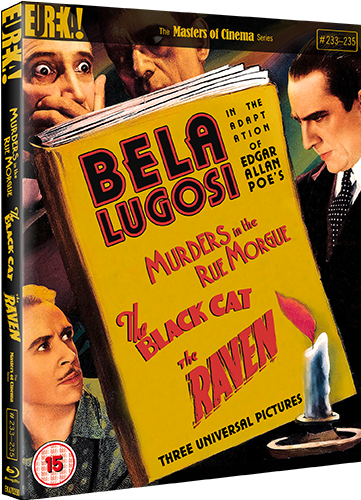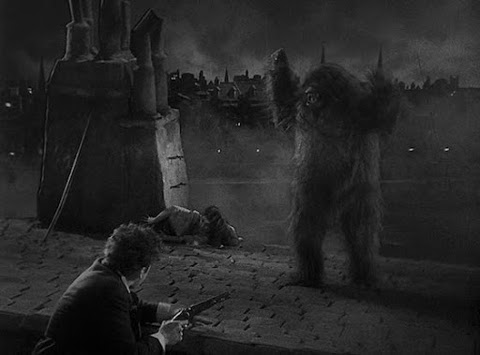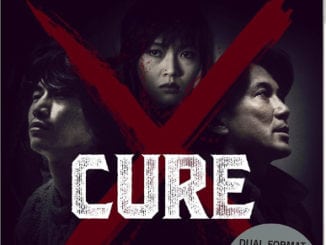Murders in the Rue Morgue (1932)
Directed by: Robert Florey
Written by: Dale Van Every, Edgar Allan Poe, John Huston, Robert Florey, Tom Reed
Starring: Bela Lugosi, Bert Roach, Leon Ames, Sidney Fox
USA
AVAILABLE ON BLU-RAY: 2OTH JULY, in the THREE EDGAR ALLAN POE ADAPTATIONS STARRING BELA LUGOSI Boxset from EUREKA ENTERTAINMENT
RUNNING TIME: 61 mins
REVIEWED BY: Dr Lenera
In 19th century Paris, medical student Pierre Dupin, his fiancée Camille L’Espanaye, and two friends, are visiting carnival sideshows and come across one by a certain Dr. Mirakle, who is exhibiting Erik, an intelligent gorilla who Mirakle understands and can hold conversations with. When both man and ape show an interest in Camille, the group leaves. Mirakle is actually responsible for a series of murders of young women in the city, and wants to mate Erik with a human, but none of the candidates have been suitable….until now….
When one thinks of Universal Horror, it’s usually the films featuring Dracula, Frankenstein, the Wolf Man, and the Mummy that come to mind, but the studio did make a number of horror films not featuring these classic characters, which tend to be not quite so popular. Probably the most interesting are the three Edgar Allan Poe-inspired movies, also made during that wonderful period from 1930 to 1934 which was a real golden age for horror, and just before the Production Code severely tightened censorship, which comprise Eureka Entertainment’s latest box set, a box set that I was eagerly waiting to delve into once I’d found the time. Very longtime readers of this website may recall that, many years ago, I reviewed these three films in a series which comprised of my thoughts on nearly all of the Universal horrors, but will hopefully find these new reviews still worth reading, as they will largely consist of new material. The first of the three films, Murders In The Rue Morgue, is undeniably the weakest, but that’s not at all to say that it isn’t of considerable interest, especially when viewed a second time, even if it’s still a bit of a strange, almost disconcerting experience. It’s often rather awkward, is sometimes unintentionally amusing [something the next two films manage to mostly avoid being to modern eyes], and makes little sense, but it has some striking scenes, is great to look at, and has that unique, one-of-a-kind performer Bela Lugosi in full flow, while in fact many of its flaws can seemingly be put down to the hugely extensive re-editing done by Universal.
The studio came up with the idea of adapting Poe’s short detective story, one of three featuring C. Auguste Dupin who was a precursor to Sherlock Holmes, while Dracula was in release and Frankenstein was being prepared, with Lugosi set to star and George Melford of the Spanish-language version of Drácula to direct. Then Robert Florey was asked to direct what was something of a compensatory package for him and Lugosi who had both been replaced on Frankenstein. But Universal then severely cut the budget and Florey left only to return later, while Florey and Tom Reed’s screenplay was modified by no less than John Huston, then a staff writer, who tried to bring Poe’s prose style into the dialogue, though one wonders why seeing as there was virtually nothing of Poe’s tale in the film except for the setting, a killer ape [an orangutan which became a gorilla] a hero whose surname is similar to Lupin, though he’s not a detective, and one scene. When Frankenstein became a big success, Universal increased the budget back to more than it originally was, got Dale van Emery to write some new scenes, and did retakes and much reordering of others. Some sources then say that it was cut down from 75 or even 80 minutes to 62 minutes at the behest of thw MPAA; however, others claim that it never had either of those longer running times, though some cuts were probably made – I reckon that the idea of Mirakle wanting to mate his gorilla with a human woman was originally more obvious; all that remains is some talk of “mixing blood” – and some regional censor boards trimmed the scene of a woman tied to a cross and shots of dancing girls. All of Universal’s tinkering didn’t really pay off though; Murders In The Rue Morgue made money, but wasn’t the smash that the previous two horrors were. It was banned in Lugosi’s native Hungary.
As with Dracula and Frankenstein, the most famous piece from Tchaikovsky’s ‘Swan Lake’ plays again over the titles, behind which you can glimpse the same images of eyes and artwork for when Lugosi was intended to play the Monster in Frankenstein which also accompanied that film’s opening titles. At the fairground, Mirakle’s communicating with Erik is pretty funny, with Mirakle speaking gibberish to the ape who then whispers growls into Mirakle’s ear and he translates what the gorilla’s saying in English. Even 1932 audiences may have fell about laughing. Then Mirakle absurdly states to the audience his intention to “mix the blood of man and ape”. Seeing that he’s really talking about mating, why on earth would he make his intentions so public? When Camille and Lupin are invited up onto the stage, Erik takes Camille’s bonnet and then almost chokes Lupin to death. Mirakle says that Camille has “made a conquest”, then get some very flowery vows of love from Lupin to Camille. But Mirakle is out and about the next night, and comes across a fight between two men over a woman in a beautifully fog shrouded street. I wonder if it was originally explained that the woman [billed as ‘woman of the streets’] was a prostitute, and that the two men were either clients fighting over her or a client and her pimp, though it still ends in a surprisingly bloody fashion before we next see her, first in shadow and then properly, writhing on a cross for a surprisingly long time while Mirakle injects her blood with something. It’s incredibly Sadean for the time. But “her blood is rotten”, implying that she has a venereal disease, so Mirakle flies into a rage while the woman dies and her body is released through a trapdoor by his assistant Janos, becoming the latest in several corpses discovered in the Seine which have all had a foreign substance injected into them.
So far pretty good, but after this the film slips a bit. Leon Ames is a very dull male lead, and though he’s not playing Poe’s detective, the medical student still has a loft where he has lots of beakers and early forensic stuff, cue for some slightly amusing banter with his long-suffering roommate. The comedy, of which there is much more than in the following two films, climaxes in a scene [which is actually from Poe] where several people are trying to get their point across but are all speaking different languages, but some of this seems like padding. A montage of courting couples in a park is strange, but then it’s not that different from an early scene of patrons, some of them couples, at the carnival reacting in different ways to the female dancers, with some near the knuckle exchanges like,”Do you bite”?, “Oh yes, but you have to pay extra”, that may not have made it in three years later. The climax has the ape doing something for no apparent reason that loads of successive creatures used as servants would do, then the rather exciting sight of Erik leaping about the rooftops of Paris carrying Camille. This has hugely impressive special effects for the time; both the model work and the forced perspective are extremely well done. Watching this scene, it becomes apparent that the model of this film was actually The Cabinet Of Dr Caligari, and this partly extends to the sets and the whole look. When the script is at times poor, there ‘s almost always something interesting to look at. The sets are full of beams in the ‘wrong’ places while Karl Freund’s cinematography uses things like forced perspective, odd angles and loads of shadows, the culmination of the latter perhaps being when the shadow of Erik’s huge hand seems to rise out of Camille’s neck. Of course there’s always loads of fog whenever it’s outside. It never feels like you’re in Paris, but it does feel like you’re in a kind of alternate reality.
Erik is played by Charles Gemora, a guy who seems to have spent most of his career in gorilla suits, and who even repeated this role in a 1954 remake called Phantom Of The Rue Morgue. Even by 1932 he had the way gorillas move down to a tee, and the ape suit looks reasonably realistic, but then his scenes are from a distance, so we don’t see his face very clearly. The decision to cut his close-ups and edit in shots of a real chimpanzee [not even a gorilla] may have been due to the face of the suit being deemed inadequate, but these shots don’t match the others very well at all, and this animal looks rather cuddly and cute and not at all like the monster that he’s supposed to be. Unfortunately it would be largely this film and next year’s King Kong that would cement gorillas as evil menaces, and they would rarely be portrayed in a good light for ages afterwards. Saying that, it’s of course Mirakle who’s the real monster here, though Jack Pierce’s makeup seems to have gone a bit astray. While Lugosi looks striking with his curly hair, obviously bright lips and his bushy eyebrows that merge into one, sometimes one eyebrow is far higher than it is on other occasions. As for his performance, it may be over the top by today’s standards and the way he says some English words may seem strange to those not used to the Hungarian accent, but he’s genuinely frightening – and yet oddly the character seems genuinely hurt when Camille turns him away, and he has a few other slight touches of vulnerability. All three of his performances in this trilogy of films differ somewhat, even though two of them are of mad scientists; only later did his mad scientists seem to merge into one as Lugosi became typecast in this kind of part.
While nobody else but James Whale should have directed Frankenstein, that film would have probably looked even more stylised if it had retained Florey at the helm, and it’s a shame that he only directed one other horror film, 1953’s The Beast With Five Fingers. Even the camera is sometimes used in inventive ways. One must remember that it hadn’t been long since sound had come along, something that had made movies very static because of the limited recording devices that were available. Therefore things like having the camera on the swing that the person that it’s photographing is swinging on would have seemed quite innovative. The girl being photographed is Sidney Fox, who’s top-billed. Her short-lived career was all-but ruined due to rumours of affairs with head of Universal Carl Laemmle and his son all but ruining her career, and she died at age 34 in 1942 from an overdose of sleeping pills. Noble Johnson, an African-American in Whiteface [!] manages to just about make an impression as Janos, the assistant of Mirakle who’s obviously intended to remind us of Fritz in Frankenstein, though he does very little and only says one word. I can’t deny that Murders In The Rue Morgue has some fine things in it and there are some fans of old-time horror movies who claim it’s an unheralded classic. I disagree with this though, I don’t think it gets there, the film instead seeming to alternate good with average, as well as being a bit of a mess, but when it’s good it’s very good indeed.
Rating: 









This first came out on Blu-ray in France from Elephant Films, then in North America from Shout! Factory. Eureka probably use the same print with a new encode. I only previously owned in on DVD, so the Blu-ray is a substantial improvement, even if it’s no doubt many generations from the original negative. Most of the imperfections seen on the DVD such as crackles and lines are gone; only a few minor marks remain. Eureka have included an alternate version previously available on the Elephant release, featuring some added music. Seeing as the ambient nature of the music is definitely not what you would expect to hear in 1932, this is probably best avoided, though kudos to Eureka for including it anyway.
William Henry Mank gives us a very packed audio commentary which was one of two on the Shout! Factory disc, managing to be fairly scene specific while piling on the appreciation and the knowledge. He tells us what some of the moved around scenes were, which explains why Lugosi has a tremendous entrance in lots of fog soon after a more un-dramatic appearance in the finished picture. We also learn that the costumes came from a version of La Boheme, that an actual ‘ape-men’ terrorised Hollywood in 1932, and of the pretend documentary that probably inspired this film’s bestiality aspect. Mank never doesn’t sound like he’s reading from notes, but there’s not a dull moment either, and he even succeeds in not losing the listener even when he stops some stories at a certain point to return later.
The second commentary might be missing, but Kim Newman, typically wearing a blazer but this time one with posters of old horror and sci-fi movies all over it, gives a typically erudite look at the films and their influence, along the way quite rightly naming The Cabinet Of Dr. Caligari as one of the most influential movies ever, and stating how Poe was an example of a horror property that was uniquely centred around a writer rather than a character. And finally we end with what was a real treat to this Poe-lover; an audio recording of Lugosi reading out Poe’s The Tell-Tale Heart. I mention in my review of The Black Cat that Lugosi seems perfect for reciting Poe, and this very enthusiastic telling proves it.
BOXSET SPECIAL FEATURES
*Limited Edition Set [2000 copies]
*O-Card Slipcase
*48-PAGE collector’s booklet featuring new writing by film critic and writer Jon Towlson; a new essay by film critic and writer Alexandra Heller-Nicholas; and rare archival imagery and ephemera
*High Definition Blu-ray (1080p) presentations for all three films, with The Raven presented from a 2K scan of the original film elements
*Uncompressed LPCM monaural audio tracks
*Optional English SDH subtitles
MURDERS IN THE RUE MORGUE
*Audio commentary by Gregory William Mank
*Alternative audio track
*New interview with critic and author Kim Newman [28 mins]
*Bela Lugosi reads “The Tell-Tale Heart” [13 mins]
REVIEW OF ‘THE BLACK CAT’ COMING UP SHORTLY!








Be the first to comment